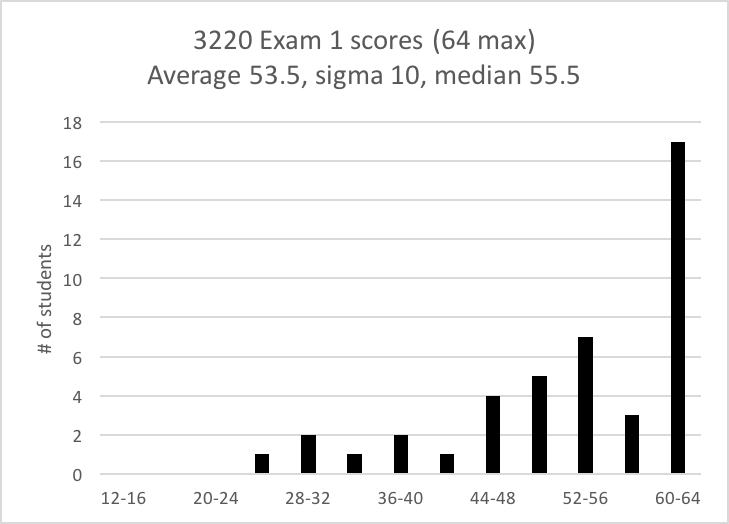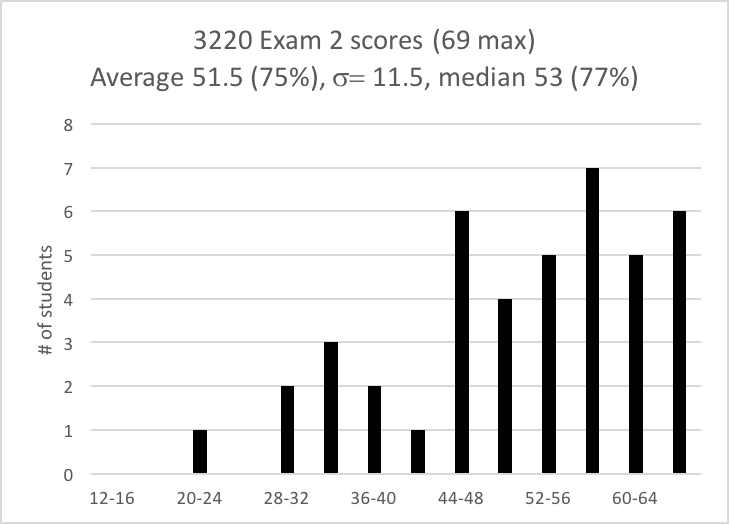Exams
This page will contains information about the mid-term and final exams, including dates, times and locations, and results.
Your individual scores and solutions will be provided via the D2L system at learn.colorado.edu. There, you can also find homework solutions.
3220 exams can include anything we have assigned in the readings (text and lecture notes), will have a mix of homework-style calculations and concept-test style questions. (Note that all concept tests, including a few extras we didn't get to in class, are available from the concept test link on the home page. Ditto the preflights, and the Tutorials are available from the calendar page)
See our "course learning goals" page for a pretty detailed list of topical areas that I think summarize what we've been up to this term.
You can bring a one page (one side!) hand-written crib sheet of your own per exam (so, two sides for exam 2, 3 sides for the final).
Here is the detailed grade information page (explaining how we compute course grades)
|
|
|
|
Exam 1 |
(See below!) Also see "course learning goals" link for more details! |
 |
Exam 2 WED (!) Nov 2 , 7:30-9:30 PM, Same location as last time |
See below |
 |
Final exam Location will be our regular classroom |
The final *will* be "cumulative" (highlights from earlier material will reappear) |
 |
Final exam results:
The final exam average was 71% (median was 74%) Just a few points below midterm #2. If you want to see your exam or get it back, let me know, we can arrange a time for you to swing by my office.Final exam information: We will cover everything we have done in lecture, readings, or homework up through the last week of the term. As usual, expect a mix of both conceptual and computational questions. (Note that all concept tests, including a few extras we didn't get to in class, are available on our website. Ditto the weekly preflights, and the optional Tutorials)
See our "course learning goals" page for a pretty detailed list of topical areas that I think summarize what we've been up to this term.
I will provide a crib sheet with the exam, (Let me know if you spot a typo, or something missing you think I should add!) - it contains basic formulas that appear in McIntyre's summaries.
IN ADDITION, you can bring "three sides" (you get one side per exam!) of your own hand-written crib sheet of your own per exam. You can bring a calculator, it might be handy (If it's programmable, just don't store anything course-related on it, please. Use your judgement.) Obviously, no internet or other connectivity during exams)
The final exam covers everything from the term. See below and the course learning goals page for details! The final will add some NEW material not covered earlier, specifically:
Chapter 6: Unbound states (particles with E>V in regions of constant V), wave packets, the uncertainty principle, and "scattering" (reflection and transmission" through wells and barriers.
Chapter 7: Angular momentum. Separating CM forom relative motion, separating variables in spherical coordinates. Using and applying angular momentum ideas (from earlier in the term) to predict motion of particles on a ring or a sphere. Use and interpret both "position space" representations (the Legendre functions and Spherical Harmonics) and also the Dirac notation |L, m> to predict experimental outcomes.
Chapter 8: This will not be heavily emphasized, but may serve as a "context" to ask questions about Ch 7 ideas. You should know the basic "|n,l,m>" notation for wave functions, and what those three quantum numbers tell you.
POST Exam 2 info: Exam 2 has been scored - your score is now on D2L. The class average was 75% , with a median of 77% (half the class did better than that) Standard deviation was 17%. (There is a histogram above, showing the numerical scores out of 69 possible exam points.) The detailed grade information page tells how we compute final scores (this midterm is worth 18% of your total course score) If you are unhappy with your score - take a look at the solutions, and then come see Prof. Pollock in office hours (or by app't), let's try to help you get the score you want on the next midterm.
PRE Exam 2 info: We will cover everything we have done in lecture, readings, or homework up through the week before the exam. Like the first midterm, expect a mix of both conceptual and computational questions. (Note that all concept tests, including a few extras we didn't get to in class, are available on our website. Ditto the weekly preflights, and the optional Tutorials)
See our "course learning goals" page for a pretty detailed list of topical areas that I think summarize what we've been up to this term.
Here are some exam review questions (we may have time to go over some of them in L31 on Wed, but if not, they may still be helpful as practice/exam review. Here are the answers, but don't peek too quickly!) )
I will provide a crib sheet with the exam, (Let me know if you spot a typo, or something missing you think I should add!) - it contains basic formulas that appear in McIntyre's summaries.
IN ADDITION, you can bring a one page (BOTH sides - you get one side per exam!) hand-written crib sheet of your own per exam (so, 2 sides for this one, 3 sides for the final). You can bring a calculator, it might be handy (If it's programmable, just don't store anything course-related on it, please. Use your judgement.) Obviously, no internet or other connectivity during exams)
The topics we have covered for Exam 2 include everything from Ch 1 and 2 (see the "exam 1 info" section below for a reminder)
For more details, see course learning goals page
Chapter 2: On exam 1 I didn't have any questions on the "Uncertainty principle" (sedtion 2.5), but that is fair game for this midterm.
Chapter 3: Time dependent Schrodinger Equation, and its general solution method when H is time independent. Spin precession in arbitrary magnetic field directions. This includes the Rabi formula (Eq. 3.63), which will be on my crip sheet.
I will NOT test you on time-dependent Hamiltonians (section 3.4)
Chapter 4: Entangled 2-particle states (including the various notations we used in class), including basic bra-ket calculations. The EPR setup (with a maximally entangled spin-0 starting state) and calculations of quantum OR hidden-variable outcomes of arbitrary spin experiments and their correlations.
I will NOT test you on "Schrodinger's cat" (section 4.2)
Chapter 5: Schrodinger's time-independent equation (the eigenvalue equation). The position and momentum operators in position space, and the Hamiltonian in position space. Calculations of brackets and expectation values in position space. Calculation and interpretation of "Probability density function" (|psi(x,t)|^2) The infinite square well solutions, the finite square well solutions, qualitative wave function sketches, and time dependence of spatial wave functions.
I will NOT test you on numerical solutions to the Schrodinger equation (section 5.10.2), nor on the quantitative solutions to asymmetric wells (5.9),( though I might ask for sketches or qualitative features as described above)
No chapter 6 material on this midterm -
POST Exam 1 info: Exam 1 has been scored - your score is now on D2L. (If you looked during a very short window on Sat around 4:30 there was a glitch - it reported your points (out of 64) but would have looked like a percent. It is now correct. )
The class average was a whopping 83.5%, with a median of 86.7 (half the class did better than that!) Standard deviation was 16%.
(There is a histogram above, showing the numerical scores out of 64 possible exam points.)
These are super high results - nicely done!! The detailed grade information page tells how we compute final scores (this midterm is worth 16% of your total course score) If you are unhappy with your score - take a look at the solutions, and then come see Prof. Pollock in office hours (or by app't), let's try to help you get the score you want on the next midterm.
PRE Exam 1 info: Exam 1 will cover everything we have done in lecture, readings, or homework up through the week before the exam. Expect a mix of both conceptual and computational questions. (Note that all concept tests, including a few extras we didn't get to in class, are available on our website. Ditto the weekly preflights, and the optional Tutorials)
See our "course learning goals" page for a pretty detailed list of topical areas that I think summarize what we've been up to this term.
I will provide a crib sheet with the exam, it will contain basic formulas that appear in McIntyre's summaries.
IN ADDITION, you can bring a one page (one side!) hand-written crib sheet of your own per exam (so, two sides for exam 2, 3 sides for the final). You can bring a calculator, it might be handy (If it's programmable, just don't store anything course-related on it, please. Use your judgement.) Obviously, no internet or other connectivity during exams)
The topics we have covered for Exam 1 include the following. (But for more details, see course learning goals page)
Chapter 1: Stern-Gerlach Experiments, Spin Quantization, Cascaded Stern-Gerlach Analyzers, Quantum State Vectors (kets), Conjugate Vectors (bras), Normalization/orthogonality/completeness. Inner products, Matrix Notation, General Quantum Systems, Postulates of Quantum Mechanics
Chapter 2: Operators, Eigensystems (Eigenvectors, Eigenvalues, Matrix Representation and Diagonalization), Spin Components in a General Direction, Hermitian Operators, Quantum Measurements (Projection Operators and Measurement Postulate), Commuting Observables, Uncertainty Principle, S.S operator, Spin 1 (or more general) systems.
_______________________________________________________________________________________________